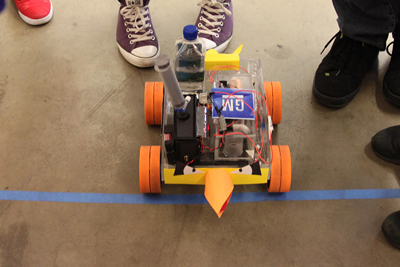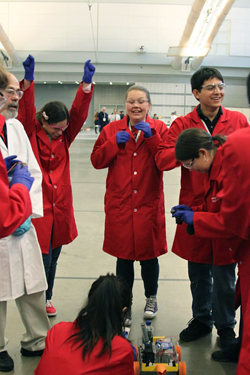ChemE car 'Zapdos' takes first place at nationals
By Anne Ju


The Cornell ChemE Car team has done it again. For the third time since 2008, the student engineering team won the national American Institute of Chemical Engineers ChemE Car competition, Oct. 28 in Pittsburgh.
The annual competition requires students to build a chemical-powered car, about the size of a shoebox, that can travel between 50 and 100 feet carrying a water payload of up to 500 milliliters. It must be powered and stopped only by a chemical reaction -- no commercial batteries and, certainly, no brakes or other mechanical or electronic stopping devices.
The Cornell car, called Zapdos after a Pokemon character, bested the competition of more than 30 other schools as the most accurate and consistent car -- 0.03 meters off the target stopping point on its first run, and a perfect stop on the second run.
Zapdos was powered by a zinc-air battery, which performed consistently and was relatively easy to make, according to senior team captain Jennifer Brenner '13. The team's stopping method was tried-and-true: An iodine clock reaction, which consists of two solutions that remain clear for a certain time depending on their concentration. When the solution turns dark blue, a light sensor opens a circuit, stopping the car.
The team competed at nationals after placing second at the Northeast regional competition at University of New Haven in West Haven, Conn., held in March. There, they entered two cars: Zoidberg III, powered by batteries, and Pikachu, powered by hydrogen.
Throughout the year leading up to competition season, the team builds a total of four cars to test different designs, Brenner said. The students hope to bring Zapdos to the international competition in South Korea in August 2013. They're also preparing for the next regional competition, in March 2013, at the University of Massachusetts.
The project team is not only for chemical engineers; students from mechanical, electrical and even biological engineering have played key roles in the car's success, Brenner noted.
"Working in a team environment, we not only have to explain our ideas to other people, but also accept ideas from other people," she said.
She added: "It's nice to have a different way to apply chemical engineering."
The team is advised by Jeffrey Varner, associate professor of chemical and biomolecular engineering. More information is available online.
Media Contact
Get Cornell news delivered right to your inbox.
Subscribe